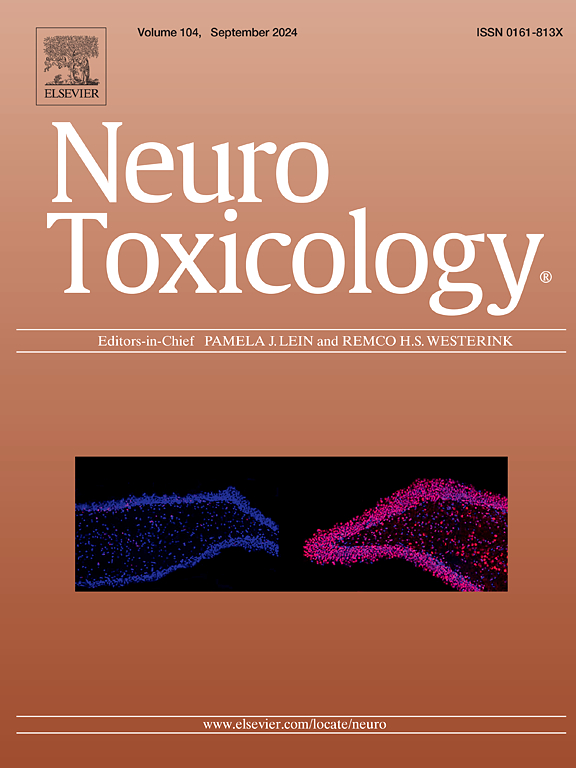职业性锰暴露中的胆碱能功能障碍。
IF 3.9
3区 医学
Q2 NEUROSCIENCES
引用次数: 0
摘要
背景和目的:过量暴露于锰(Mn)会产生帕金森病和认知障碍的临床综合征。然而,我们对锰神经毒性机制的理解仍然有限。本研究旨在评估锰暴露、胆碱能功能和暴露工人认知障碍之间的关系。方法:采用囊状乙酰胆碱转运体(VAChT)放射性示踪剂(-)-(1-(8-(2-[(18)F]氟乙氧基)-3-羟基-1,2,3,4-四氢萘-2-基)-哌啶-4-基)(4-氟苯基)甲烷(VAT)和正电子发射断层扫描(PET)评估21名mn暴露工人的脑胆碱能功能。我们通过工作经历和MRI苍白指数来估计职业Mn暴露。认知控制测试包括语言流畅性(VF)、字母数字排序(LNS)、双背字母任务(2B)、Go-No-Go (GnG)和Simon任务。我们将广义线性模型应用于锰暴露、基于体素的胆碱能PET和认知控制措施,估计胆碱能介导的锰与认知功能之间的关联系数。我们利用自举技术来验证中介系数。结果:两种锰暴露指标都与尾状和皮质区域的低胆碱能VAT结合有关,包括楔前叶、三角部、包部、中颞叶和内嗅皮层。区域胆碱能功能介导了锰暴露与复合认知控制评分(5项认知测试的平均值)[β= -0.661, 90%可信区间(CI) -2.130, -0.032]和个体VF评估(β= -0.944, 90% CI -2.157, -0.065)之间的关系。讨论:高锰暴露与大脑多个区域胆碱能活性降低有关。胆碱能功能也介导了锰暴露与认知控制表现之间的部分关系。尾状核和皮质胆碱能活性可能是早期Mn神经毒性的生物标志物,是帕金森综合征认知功能障碍的重要机制。本文章由计算机程序翻译,如有差异,请以英文原文为准。
Cholinergic dysfunction in occupational manganese exposure
Background and objective
Excessive exposure to manganese (Mn) produces a clinical syndrome of parkinsonism and cognitive impairment. However, our understanding of the mechanisms of Mn neurotoxicity remains limited. This study aimed to evaluate the relationships between Mn exposure, cholinergic function, and cognitive impairment in exposed workers.
Methods
We assessed brain cholinergic function using vesicular acetylcholine transporter (VAChT) radiotracer (-)-(1-(8-(2-[(18)F]fluoroethoxy)-3-hydroxy-1,2,3,4-tetrahydronaphthalen-2-yl)-piperidin-4-yl)(4-fluorophenyl)methanone (VAT) with positron emission tomography (PET) in 21 Mn-exposed workers. We estimated occupational Mn exposure from work histories and the MRI pallidal index. A cognitive control battery consisting of the Verbal Fluency (VF), Letter Number Sequencing (LNS), Two-Back Letter Task (2B), Go-No-Go (GnG), and Simon Task assessed cognitive function. We applied generalized linear models to Mn exposure, voxel-based cholinergic PET, and cognitive control measures, estimating coefficients for cholinergic-mediated associations between Mn and cognitive function. We utilized bootstrapping techniques to validate the mediation coefficients.
Results
Both Mn exposure metrics were associated with low cholinergic VAT binding in the caudate and cortical regions including the precuneus, pars triangularis, pars opercularis, middle temporal lobe, and entorhinal cortex. Regional cholinergic function mediated the relationship between Mn exposure and both the composite cognitive control score (mean of the 5 cognitive tests) [β = -0.661, 90 % confidence interval (CI) −2.130, −0.032] and the individual VF assessment (β = −0.944, 90 % CI −2.157, −0.065).
Discussion
Higher Mn exposure is associated with lower cholinergic activity in multiple brain regions. Cholinergic function also mediates a portion of the relationship between Mn exposure and cognitive control performance. Caudate and cortical cholinergic activity may be a biomarker of early Mn neurotoxicity and represent an important mechanism of cognitive dysfunction in parkinsonian syndromes.
求助全文
通过发布文献求助,成功后即可免费获取论文全文。
去求助
来源期刊

Neurotoxicology
医学-毒理学
CiteScore
6.80
自引率
5.90%
发文量
161
审稿时长
70 days
期刊介绍:
NeuroToxicology specializes in publishing the best peer-reviewed original research papers dealing with the effects of toxic substances on the nervous system of humans and experimental animals of all ages. The Journal emphasizes papers dealing with the neurotoxic effects of environmentally significant chemical hazards, manufactured drugs and naturally occurring compounds.
 求助内容:
求助内容: 应助结果提醒方式:
应助结果提醒方式:


